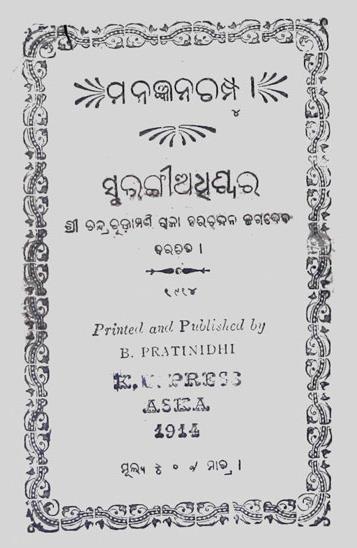Published in 1914, Managyana Champu is a distinguished work of poetry by Chandrachudamani Harichandana Jagadeba that captures the essence of human emotion, philosophy, and the beauty of poetic form. This anthology reflects the rich literary tradition of India and showcases Jagadeba’s mastery of the champu style—a hybrid form that blends prose and poetry in a seamless, melodic narrative.
The early 20th century was a vibrant era for Indian literature as the country navigated the complexities of colonial rule while simultaneously engaging in a cultural renaissance. Poets and writers sought to assert a distinct identity, striving to revive ancient traditions while also exploring contemporary themes. In this context, Managyana Champu emerges as both a celebration of cultural heritage and a profound commentary on the human condition.
Jagadeba’s work is steeped in traditional themes, yet it resonates with the trials and aspirations of modernity. The interplay between the classical and the contemporary within Managyana Champu exemplifies the poet’s intent to bridge gaps between past and present, offering a space where timeless wisdom can inform current realities.
Managyana Champu delves into numerous themes, including love, devotion, nature, and the quest for knowledge. The title suggests a celebration or homage to the divine, with Managyana connoting auspiciousness or well-being. Throughout the collection, Jagadeba weaves intricate narratives that explore the complexities of human relationships and the search for meaning within them.
The poems reflect profound philosophical inquiries, often questioning the nature of existence, the role of fate, and the human spirit’s resilience. There is a palpable depth of emotion in Jagadeba’s writing, inviting readers to engage with their own experiences of joy, sorrow, and transcendence. The poet’s ability to articulate the intricacies of love and devotion resonates deeply, capturing the universal human experience while celebrating the particularities of Indian spirituality.
One of the defining features of Managyana Champu is its unique style. The champu format allows for a dynamic interplay between prose and verse, creating a rhythmic, captivating flow that engages readers from the outset. Jagadeba’s careful attention to meter and rhyme enhances the lyrical quality of his verses, while the narrative prose sections provide context and depth.
The use of vivid imagery is a hallmark of Jagadeba’s poetry. He utilizes natural motifs—such as landscapes, flora, and fauna—to evoke emotions and symbolize deeper truths. This rich imagery not only paints a vivid picture for readers but also establishes a connection between the external world and the internal journey of the self.
Managyana Champu stands as a significant contribution to early 20th-century Indian poetry, influencing subsequent generations of writers and poets. Jagadeba’s innovative approach to the champu form has inspired literary experimentation, encouraging others to explore and redefine traditional poetic structures.
Moreover, the themes that permeate Managyana Champu continue to resonate in contemporary discourse, reflecting an enduring interest in the complexities of love, spirituality, and the human experience. Jagadeba’s ability to impart wisdom through poetic expression makes this work a timeless treasure in Indian literature.
Books Info
| Books name | Managyana Champu / ମନଜ୍ଞାନ ଚମ୍ପୁ |
| Author | Chandrachudamani Harichandana Jagadeba |
| No Of pages | 44 |
| Publisher | B. Pratinidhi |
| Publication | 1914 |
| Printed At | B. Pratinidhi K. C Press |
| Distributor | NA |

